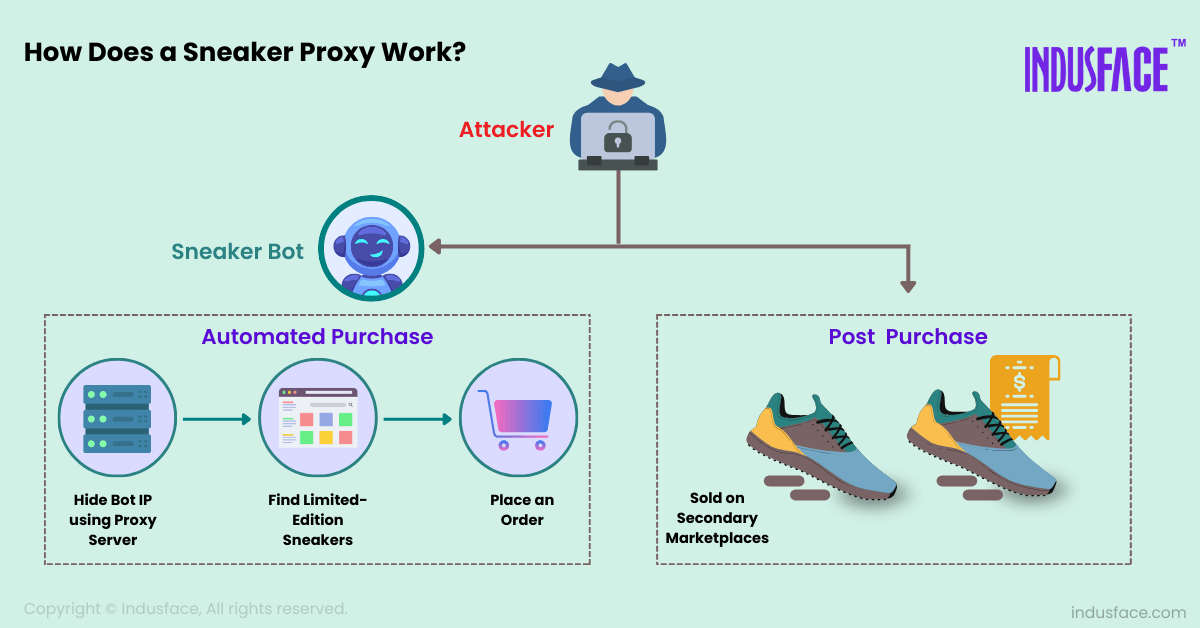Introduction to Sneaker Bots
Sneaker bots, also called shoe bots, are automated software programs or scripts used to rapidly purchase limited-release sneakers from online retailers, often for resale at higher prices.
These bad bots leverage advanced algorithms to navigate through sneaker websites, bypass queue systems, solve CAPTCHA challenges, and complete the checkout process quickly and efficiently.
Sneaker bots have gradually evolved to target most items that are restricted in quantity.
Nike Shoe Bot (NSB), AIO Bot, Cybersole, Another Nike Bot (ANB), and Dashe are examples of sneaker bots widely used by enthusiasts and resellers to automate the purchase of limited-release sneakers from various online retailers
The Inner Workings of Sneaker Bots

Sneaker bots function by automating the process of purchasing limited-release sneakers from online retailers. They monitor release calendars by leveraging crawler bots, bypass queues, solve CAPTCHA challenges, and automate the checkout process through card cracking bots or using legit cards.
They utilize advanced algorithms and proxy support to secure sneakers quickly and efficiently. Developers regularly update and adapt these bots to counter changes in retailer websites and enhance their effectiveness.
In some instances, they leverage cross-site-scripting(xss), a website vulnerability, to inject mouse recording and screen recording javascript to study user behaviour and design bots to exactly mimic user behaviour.
Overall, sneaker bots streamline the purchasing process, allowing users to increase their chances of acquiring coveted sneakers in highly competitive online releases.
The Impact of Sneaker Bots on Online Retailers and Consumers
The widespread use of sneaker bots has had significant impacts on both retailers and consumers in the sneaker industry.
Retailers such as Adidas and Nike experience surges in website traffic during high-demand releases, but this influx can strain server capacities and compromise the user experience.
For instance, during the release of the Adidas Yeezy Boost 350 V2 “Zebra”, Adidas’ website crashed within minutes due to overwhelming bot traffic, leaving many genuine buyers unable to complete purchases.
Similarly, Nike’s SNKRS app often faces bot-driven attacks during hyped releases like the Off-White x Nike collaborations, leading to widespread frustration among users who encounter errors or delays in the purchasing process.
Additionally, retailers face challenges from bot-driven reselling, as limited-edition sneakers acquired by bots are often resold at exorbitant prices on secondary markets like StockX or eBay, diverting profits away from retailers and inflating prices for consumers.
Identifying Sneaker Bots
Traditional bot detection methods such as malicious IPs, user agents and so on will provide some coverage.
However, for identifying more subtle patterns, AI and ML enabled bot mitigation systems are necessary. By analysing large datasets on a wide range of user behaviour metrics including mouse movements and keystrokes, session duration, interaction frequency, and browsing patterns, these algorithms can identify deviations that may indicate bot activity, even if the bot has been trained to mimic human behaviour.
ML models also continuously adapt and evolve based on new data and emerging trends. This means that even if bots evolve to become more sophisticated in their mimicry of human behaviour, ML models can learn from these new patterns and update their detection strategies accordingly. This adaptive learning capability allows AI-powered systems to stay ahead of evolving bot tactics and maintain effective mitigation measures over time.
Overall, leveraging AI and ML technologies can enhance the effectiveness of bot detection efforts, enabling retailers to combat sneaker bot activity more effectively and uphold fairness in the sneaker marketplace.
Bot Management Platforms’ Role in Sneaker Bot Protection
AI and ML powered bot management platforms such as AppTrana WAAP, play an important role in protecting online retailers against sneaker bots.
By performing behavioural analysis through some of the techniques describes above, these tools first identify anomalies in user behaviour and separate bots from humans.
Once the bots are identified, they deploy automated bot mitigation policies such as rate-limiting, throttling, CAPTCHA and more.
To reduce false positives, these security policies are also thoroughly vetted by the managed services team on the AppTrana WAAP – Bot Management Module.


